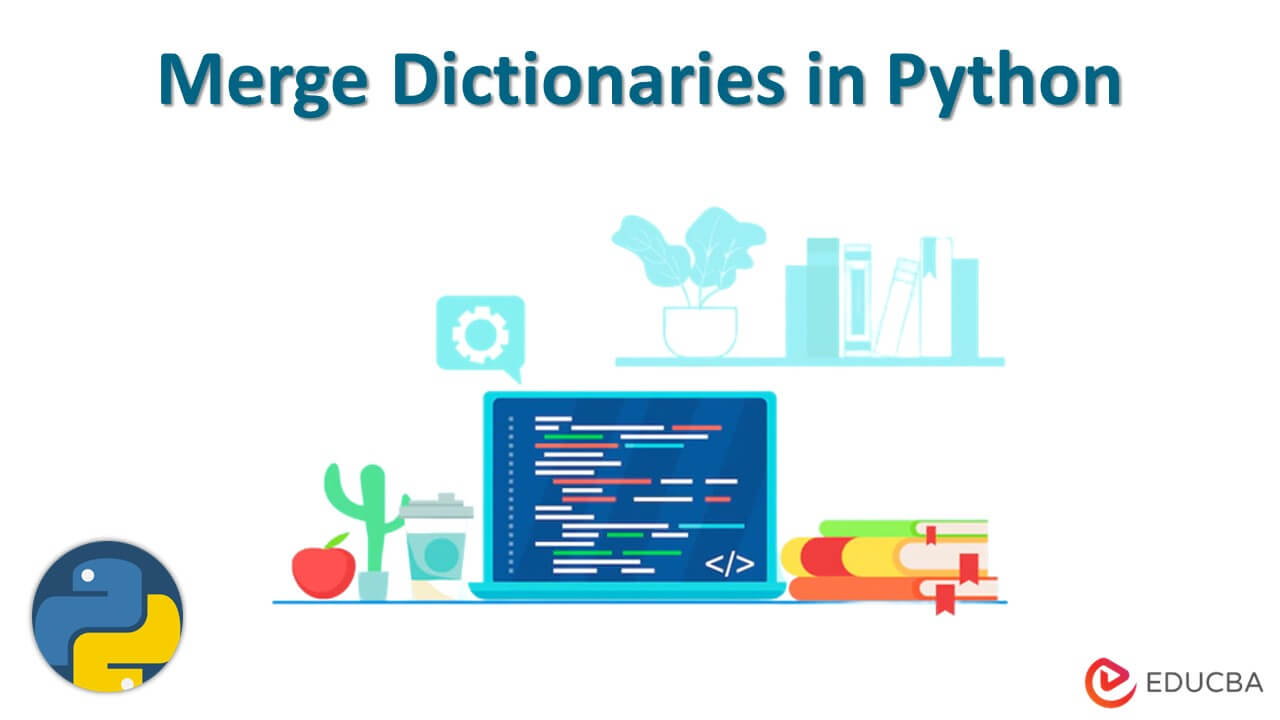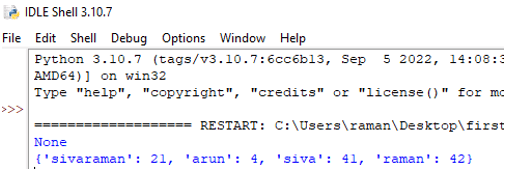Introduction to Merge Dictionaries
Merge dictionaries in python are one of the features for merging the datas like key-value pairs that are associated with the data structure. It contains all the set of elements, and each key-value pair is mapped to separate keys. All the elements of the dictionary which enclosed the curly braces and colon operator for separating key and value pairs iterate the dictionary and add the same entries to other.

Key Takeaways
- By combining dictionaries, the unpacking operator (**) can also be used.
- It is an unordered collection for accessing the key-value pairs.
- The key should be the unique one and it does not support the append method.
- Only the most recent appearance of a key in dictionary representation is kept.
- It supports Merge key-value pairs of one dictionary into another one.
What is Merge Dictionaries in Python?
It’s combining with two sets of dictionaries and the values of the same key in python. And also, concatenates the values with the same set of keys in the dictionary collection and adds all the lists in the same dictionary with the same key. In python, its hierarchical dictionary with the sum of the value changes for each set of keys using default dict. It can be helpful to extend and merge the list of dictionaries. It has some default methods like dict(), copy() and update() functions for merging two dictionaries by using the unpacking operator like ** with a single type of expression and stored in a dictionary.
How to Use Merge Dictionaries in Python?
It has some default and standard methods to achieve this functionality. The unordered collection of data elements is mainly stored in key-value pairs with specific data structures that can be held using the single value element. The specific operators like curly brackets {} along with attached brackets and commas so it denotes as ({,}) moreover the key:value pair is separated by using a semi-colon(:) in the dictionary. Some of the merge dictionary methods are as follows.
1. Update() method usage
The update() method in Python is used to combine two different dictionaries. The first set of dictionaries is mainly combined with the second one using the same overwritten technique. It can return none if no new dictionary sets are found. Because both sets of dictionaries have the same key but different values, the value of the latter dictionary will be overwritten.
Code:
def Merge(x, y):
return(y.update(x))
x = {'siva': 41, 'raman': 42}
y = {'sivaraman': 21, 'arun': 4}
print(Merge(x, y))
print(y)Output:
2. Merge(|) operator
We can combine the dictionary in a single line of code with the help of the merge operator. By using this it helps to combine the dictionaries right away.
Code:
def Merge(p, q):
outs = p | q
return outs
p = {'siva': 1, 'raman': 2}
q = {'sivaraman': 3, 'arun': 4}
ress = Merge(p, q)
print(ress)3. ** operator
It is only the expression for the other two dictionaries that are unaffected and it implies that a dictionary is an argument. We can easily send the many arguments along with a function for utilizing the dictionary with shorthand like the ** operator.
Code:
def Merge(p, q):
res = {**p, **q}
return res
p = {'siva': 21, 'raman': 22}
q = {'sivaraman': 23, 'arun': 24}
ress = Merge(p, q)
print(ress)Output:
4. Using the keys() function and the for loop
By using the for loop the keys for the dictionary are iterated and printed the same on the console screen.
Code:
def Merge(p, q):
for i in q.keys():
p[i]=q[i]
return p
p = {'siva': 1, 'raman': 2}
q = {'sivaraman': 3, 'arun': 4}
resss = Merge(p, q)
print(resss)Output:
Merge Two Dictionaries in Python
Merges typically occur as dict p – dict q, going from right to left. The value of the second dictionary replaces the value of the first dictionary when there is a common key holder in both dictionaries. This method will accomplish the dictionary on yield type for keys with iterated over. As a result, the key in dictionary2 which runs through each key in dictionary2 if the key is supposed and already exists in the merged dictionary of the larger value. It is a proper strategy for merging the two dictionaries based on max-value that given the merged is initialized with the same mappings as dictionary1. The method has a flaw with accidentally that combine with dictionary2 and dictionary1 rather than combining the two sets of dictionaries into a single set of dictionaries.
Code:
def first(inp1, inp2):
return (inp1.update(inp2))
inp1 = {'1' : 'January',
'2' : 'February',
'3' : 'March' }
inp2 = {
'4' : 'April',
'5' : 'May',
'6' : 'June'
}
first(inp1, inp2)
print("Welcome To My Domain : ")
print(inp1)Output:
The above example is to perform the python dictionary using two inputs.
1. Using a For Loop merge Dictionaries in python
A for loop can be used to cycle over a dictionary. Although there are ways to return the values as well, when looping through a dictionary, the return value is the dictionary’s keys. The drawback of this approach is how many loops are required to merge the dictionaries.
Code:
inp1 = {'January': 15, 'February': 10, 'March': 12}
inp2 = {'April': 18, 'February': 20, 'May': 16}
def func(inp1, inp2):
ress = {**inp1, **inp2}
for k, v in ress.items():
if k in inp1 and k in inp2:
ress[k] = [v , inp1[k]]
return ress
ress = func(inp1, inp2)
print(ress)Output:
We can iterate and use the n number of dictionaries in the function.
2. Merge method dictionaries in python
We know that the dict class’ merging operator (|) combines dictionaries in a single line of code by using the merge operator. With the help of the update operator (|=), also combine with the dictionaries on right away.
Code:
def operations(inp1, inp2):
ress = inp1 | inp2
return ress
inp1 = {'January': 1, 'February': 2, 'March' : 3 }
inp2 = {'April': 4,'February': 5,'May' : 6 }
outs = operations(inp1, inp2)
print(outs)Output:
FAQ
Q1. Define dictionary in python.
Answer: Python’s dictionary is an unordered set of key-value pairs with a unique key that does not support appending.
Q2. Which function aids in dictionary merging?
Answer: Use the dict() function Object() { [native code] } and **kwargs to combine two dictionaries. It is a kwargs (**) operator-based shortcut method of the dict () function.
Q3. What is the purpose of the merge operator in Python?
Answer: In the dict class in Python 3.9, the merge operator (|) was added. We can combine dictionaries in a single line of code by using the merge operator. With the help of the update operator (|=), we can also combine the dictionaries right away.
Conclusion
We have looked at a variety of techniques for combining dictionaries. But most probably we can use the | operator if you have Python 3.9 or higher versions. However, we can still utilize the other type of approaches mentioned in the above paragraphs that are supported for both older and newer versions.
Recommended Articles
This is a guide to Merge Dictionaries in Python. Here we discuss the introduction, how to use merge dictionaries in python along with code implementation. You may also look at the following article to learn more –








